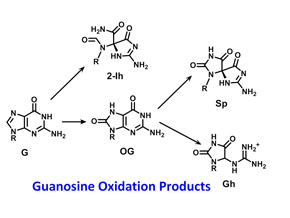Cynthia J. Burrows
 ORGANIC & BIOLOGICAL CHEMISTRY
ORGANIC & BIOLOGICAL CHEMISTRY
Distinguished Professor
Thatcher Presidential Endowed Chair of Biological Chemistry
B. A. University of Colorado, 1975
Ph. D. Cornell University, 1982
NSF-CNRS Postdoctoral Fellow, Université Louis Pasteur, Strasbourg 1981-83
Phone: (801) 585-7290
Office: 1625 Thatcher Building
Email: burrows@chem.utah.edu
Research Group
Biological Chemistry Program
Activities & Awards
- NSF – CNRS Exchange of Scientists Fellowship, 1981-82
- Japan Soc. for the Promotion of Science Research Fellow, 1989-90
- NSF Creativity Award, 1993-95
- NSF Career Advancement Award, 1993-94
- Bioorganic & Natural Products Study Section, NIH, 1990-94
- NSF Math & Physical Sciences Advisory Committee, 2005-2008
- Assoc. Editor, Organic Letters, 1999 - 2002
- Senior Editor, Journal of Organic Chemistry, 2001-2013
- Robert W. Parry Teaching Award, 2002
- ACS Utah Award, 2000
- Bea Singer Award, 2004
- Fellow, AAAS, 2004
- Distinguished Scholarly and Creative Research Award, Univ. of Utah, 2005
- Cope Scholar Award, American Chemical Society, 2008
- Director, USTAR Governing Authority, 2009-2017
- Member, American Academy of Arts and Sciences, 2009
- ACS Fellow, 2010
- Distinguished Teaching Award, 2011
- Editor-in-Chief, Accounts of Chemical Research, 2014
- Linda K. Amos Award for Distinguished Service to Women at U of U, 2014
- Member, National Academy of Science, 2014
- Utah Governor’s Medal for Science and Technology, 2016
- Willard Gibbs Medal; ACS, Chicago Section, 2018
- James Flack Norris Award in Physical Organic Chemistry; ACS, 2018
- Rosenblatt Prize, 2019
Research Interests
The heterocyclic bases of DNA and RNA are subject to chemical modification, either accidentally or on purpose. For example, endogenous oxidative stress or external agents such as radiation lead to oxidation of the guanine base in both DNA and RNA. In DNA, this process is traditionally thought to be mutagenic, and an accumulation of mutations can lead to cancer. We recently demonstrated that oxidized bases can also be epigenetic, particularly in G-rich gene promoters where they impact gene expression via the base excision repair pathway.
This research program has led to the following activities and goals in the lab:
- Understanding the mechanistic chemistry of guanine oxidation using free radical oxidants that are relevant to cellular chemistry
- Examining the reactivity and folding dynamics of G-rich sequences that form G-quadruplexes (and their complementary i-motif structures)
- Developing sequencing protocols, both nanopore and Illumina-based, for finding oxidized bases in DNA and RNA
- Using cell-based assays to understand the impact of DNA modifications on G-expression in normal vs. cancer cells
- Analyzing DNA repair activity on oxidized bases and abasic sites
- Determining the interplay of chemical modifications in DNA (genomic) and RNA (mRNA and viral RNA) with structural motifs such as G-quadruplexes. Recently, this has involved 8-oxoG in DNA and RNA, and N6-methyladenosine, pseudouridine and inosine in RNA.

For further details, please visit our group website.
Cynthia Burrows is a member of the Nano Institute of Utah.
Selected Publications
- For recent publications, please visit our publications page.
- Google Scholar: https://scholar.google.com/citations?hl=en&user=tJsozioAAAAJ&view_op=list_works&sortby=pubdate
Contact Information:
Cynthia J. Burrows, Ph. D., Distinguished Professor
U.S. Mailing address:
Department of Chemistry
University of Utah
315 S. 1400 East, Rm 2020
Salt Lake City, UT 84112-0850
Campus mailing address: 2020 HEB
Physical location:
1625 Thatcher Building
Voice: 801-585-7290
Labs: 801-585-3096
burrows@chem.utah.edu
